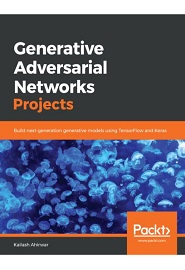
English | 2019 | ISBN: 978-1789136678 | 316 Pages | PDF | 12 MB
Explore various Generative Adversarial Network architectures using the Python ecosystem
Key Features
- Use different datasets to build advanced projects in the Generative Adversarial Network domain
- Implement projects ranging from generating 3D shapes to a face aging application
- Explore the power of GANs to contribute in open source research and projects
Generative Adversarial Networks (GANs) have the potential to build next-generation models, as they can mimic any distribution of data. Major research and development work is being undertaken in this field since it is one of the rapidly growing areas of machine learning. This book will test unsupervised techniques for training neural networks as you build seven end-to-end projects in the GAN domain.
Generative Adversarial Network Projects begins by covering the concepts, tools, and libraries that you will use to build efficient projects. You will also use a variety of datasets for the different projects covered in the book. The level of complexity of the operations required increases with every chapter, helping you get to grips with using GANs. You will cover popular approaches such as 3D-GAN, DCGAN, StackGAN, and CycleGAN, and you’ll gain an understanding of the architecture and functioning of generative models through their practical implementation.
By the end of this book, you will be ready to build, train, and optimize your own end-to-end GAN models at work or in your own projects.
What you will learn
- Train a network on the 3D ShapeNet dataset to generate realistic shapes
- Generate anime characters using the Keras implementation of DCGAN
- Implement an SRGAN network to generate high-resolution images
- Train Age-cGAN on Wiki-Cropped images to improve face verification
- Use Conditional GANs for image-to-image translation
- Understand the generator and discriminator implementations of StackGAN in Keras
Resolve the captcha to access the links!